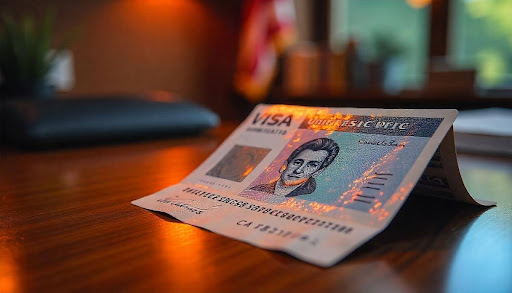Explore the complete journey from EB‑5 visa to citizenship—including timelines, investment rules, India‑specific advice, and what is EB‑5 visa USA. Understand how long it takes, who qualifies, and how to plan smartly.

For global investors and their families, the EB‑5 visa to citizenship pathway offers something unique—a chance to secure U.S. permanent residency and eventually a passport through a qualifying investment.
Unlike employment‑based visas that depend on sponsorship or family petitions, EB‑5 gives investors more independence, flexibility, and control over their immigration journey. If you have significant capital and long‑term plans to live in the United States, this route allows you to invest directly in the U.S. economy while securing a stable future for your family. Over time, it leads to one of the most valuable benefits—American citizenship.
So, what is EB‑5 visa USA, and how does it actually take you from investor to citizen? Let’s walk through the entire journey step by step.
The EB‑5 visa USA program was created in 1990 to encourage job creation and economic growth through foreign investments. Under this program, a foreign national can obtain a green card by making a qualifying investment in the United States.
The required investment is 800,000 dollars if the project is in a Targeted Employment Area, which refers to rural or high‑unemployment regions. If the project is in a regular urban area outside a TEA, the required investment is 1,050,000 dollars. In return, the investor, their spouse, and unmarried children under 21 can all obtain U.S. green cards.
There is, however, a crucial condition. The investment must create at least ten full‑time jobs for U.S. workers. Investors can either take a direct approach, where they actively manage the business that generates jobs, or choose the regional centre route, which allows them to invest in a pre‑approved project without direct management. Regional centers are popular among those who prefer a more passive investment structure with less day‑to‑day involvement. To understand these requirements in detail, you can review the official USCIS page.
The EB‑5 visa to citizenship pathway involves three major stages. First, you begin with the I‑526E petition. This petition proves that your investment meets EB‑5 requirements, that funds have been legally sourced, and that the planned project will create the required jobs. Once this petition is approved, you and your family members receive a conditional green card valid for two years. During this time, you are allowed to live, work, and travel freely within the United States.
Next comes the I‑829 petition to remove conditions. Within the 90‑day window before your conditional green card expires, you must file this petition to show that the investment remained at risk and actually resulted in job creation. If USCIS approves the petition, you transition from conditional residency to full permanent resident status.
Finally, after five years as a green card holder—including both the conditional and permanent periods—you become eligible for U.S. citizenship.
At this stage, you file Form N‑400 for naturalization. To qualify, you must have maintained at least 30 months of physical presence within the United States over five years, avoided long absences, passed an English and civics test, and demonstrated good moral character. Once approved, you gain the benefits of citizenship, including the right to vote and hold a U.S. passport. You can read more about the process on the USCIS citizenship page.

Yes, the EB‑5 visa USA program remains active in 2025, but it operates under stricter rules introduced by the EB‑5 Reform and Integrity Act of 2022. These updates have increased transparency, strengthened investor protections, and created visa reserves for rural and high‑unemployment area projects.
Regional centres are now required to register annually with USCIS and face more oversight to ensure proper use of investor funds and accurate job creation reporting.
For Indian nationals, the program continues to be available, but backlogs have historically caused delays. Fortunately, these backlogs eased in 2023 and 2024, improving timelines for new applicants.
It’s important to remember that visa availability is determined by your country of birth, not your current nationality. To track your eligibility, you should regularly check the monthly Visa Bulletin released by USCIS. If you want clarity on current wait times, Beyond Border can provide personalized guidance based on your country of birth.
If you are an Indian investor, the first step in obtaining the EB‑5 visa is ensuring your funds are sourced and transferred legally. USCIS requires clear documentation showing how the funds were earned and moved, whether through salary savings, property sales, business income, or loans. To remain compliant with Indian RBI rules and U.S. regulations, it is essential to work with a chartered accountant and an experienced U.S. immigration attorney.
The next decision involves choosing between direct investment and a regional centre. Direct investment means you will actively manage the business that creates the required jobs, while a regional centre allows you to participate passively in a larger project where job creation is calculated indirectly. Most Indian investors prefer regional centers for the convenience and reduced personal involvement they offer. Beyond Border can help you review pre‑vetted regional centre projects to ensure they meet both your immigration and financial goals.
Finally, working with a trusted immigration team is crucial for success. The EB‑5 process involves complex paperwork, strict compliance, and multiple filings over several years. Having the right experts by your side minimizes the risk of delays and ensures a smooth transition from India to the United States.
One common misconception is that your nationality affects visa wait times. In reality, it is your country of birth that determines your place in the visa queue. For example, applicants born in India or China have faced longer waiting periods in past years because of high demand. However, if you were born in a different country such as the UAE or Singapore, even if you hold Indian citizenship, you may qualify under a faster processing timeline.
Therefore, when considering EB‑5 visa eligible countries, always focus on your place of birth, not the passport you currently hold. If you are unsure how this rule affects you, Beyond Border can provide an eligibility check and estimate your wait time based on your specific circumstances.
When your initial EB‑5 petition is approved, you receive a conditional green card valid for two years. During this period, USCIS monitors your investment to ensure it remains at risk and that the required ten jobs have been created or are in progress. Before the conditional card expires, you must file Form I‑829 to remove these conditions. Once approved, you receive a standard permanent green card valid for ten years, which can be renewed indefinitely.
From the moment you first receive conditional residency, the five‑year countdown toward citizenship begins. After completing five years of green card status, you become eligible to apply for U.S. naturalization. This transition is seamless as long as you maintain proper documentation and avoid long absences from the United States.

Whether the EB‑5 visa to citizenship pathway is right for you depends on your goals and resources. For many investors, it is the cleanest and most independent route to U.S. permanent residency. Unlike employment‑based visas such as H‑1B, EB‑5 does not rely on an employer sponsor, nor does it tie your status to a specific job. The same investment covers your spouse and children, allowing your entire family to secure green cards. It also provides freedom to live anywhere in the United States without location restrictions.
However, there are a few considerations. Your investment must remain at risk for several years, and there is no guaranteed return because project performance can vary. Additionally, USCIS now applies more detailed scrutiny under the 2025 regulations, meaning thorough documentation is more important than ever. Despite these challenges, EB‑5 remains one of the most direct pathways to U.S. citizenship for high‑net‑worth individuals. If you want a clear risk and timeline analysis, Beyond Border can guide you through every step of the process.
Choosing the EB‑5 visa to citizenship pathway is about more than just making an investment. It is about securing your family’s future, gaining global mobility, and creating a permanent home in the United States. Whether you are an Indian entrepreneur, a business owner in the Middle East, or a global investor seeking stability, the EB‑5 program offers a rare opportunity to combine financial growth with immigration benefits.
From fund sourcing and project selection to USCIS filings and long‑term strategy, expert guidance makes the journey smoother and less stressful. Beyond Border is here to support you from your initial investment to the day you hold your U.S. passport.